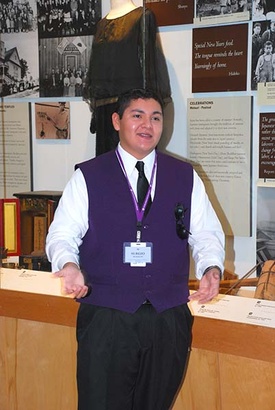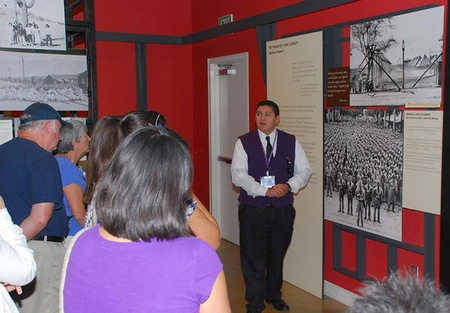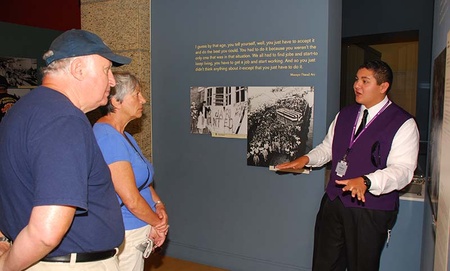Where do you come from? How did you get here? Why do you do what you do? As a public volunteer at the Japanese American National Museum, and a Docent at that, I am constantly asked for my backstory. It’s quite flattering how visitors flock to us Docents and seem so genuinely intrigued by our life stories, as if we were some type of celebrity. Perhaps it’s just general inquisitive human nature, but listening to, and sharing stories with one another helps establish a deep, personal connection.
Seeing as how it’s my first opportunity to write for the Discover Nikkei site, I figured that it would be the perfect opportunity to establish such a connection with fellow volunteers and visitors. After all, a Docent’s job is to create an interesting, personal experience people can in turn share with others.
To fully relate my story, let me take you through the rundown of the Q & A portion at the end of my tours. The question that always seems to be on people’s minds is where I received my education (mind you, they do eventually ask your name, so don’t feel discouraged).
I attended Don Bosco Technical Institute, which is a private, Catholic, all boys high school in Rosemead, California where I majored in Computer Science, and am to be a first year college student at the California Polytechnic University in Pomona majoring in Computer Science, yet again. Being a volunteer at the Japanese American National Museum visitors always assume that I am majoring in Asian-American studies or some form of humanities, so it often comes as quite a shock when I reveal my true major, to which they respond, “Oh, you must be good with numbers!” and I always retort, “Yes, Ones and Zeroes.”
Their surprise is valid though, why would a volunteer at a cultural museum be involved in the study of computers? Their next statement is always , “Oh, so you’re Japanese/Hapa/mixed!” to which I reply, “Nope. I’m a full blooded Mexican-American. Third Generation.” (If anyone reading has ever held a conversation like this, you understand just how priceless the contorted, confused faces of these people are.) Now the visitors are quite out of their element, it’s like watching a robot screech “Does not compute!”, only there’s just awkward silence mixed with muddled smiles.
Eventually someone bites and asks, “So how did you get involved with the museum?”
The search for the unknown has always fascinated me. When I was younger it didn’t matter what job I wanted—astronaut, riverboat captain, scientist—the core ideal was always present: to confront the unknown and subdue it. I could read at a very young age and I could talk before I could walk, so knowledge always intrigued me.
If you stepped into my home on any given day, you would likely have seen a cute little baby in a “onesie” with his nose in a book and a stack of them towering next to him: I was that obsessed.
When I was younger, books about Japanese American Incarceration, Slavery, the oppression of the Native Americans, weren’t readily available and it wasn’t spoken of, so there were plenty of things I didn’t know. These subjects were never brought up in class, apparently there were more pressing matters to attend to, so it came as a shock when I first heard of things like that.
Ms. Christine Nakamura, my fifth grade Japanese American teacher at Sierra Park Elementary, in El Sereno, California really opened our eyes to these injustices. It wasn’t until she spoke about the incarceration of the Japanese Americans that these pathways to knowledge were opened.
Sure, we knew who Dr. Martin Luther King, Jr. was, but we didn’t know what his movement stood for and why it was so hard for him to fight at that time. We were told about Thanksgiving and how everything was fine and dandy, but where were the lectures on the trail of tears and the massacres of the Native Americans, and no one (and I mean not a soul) knew about the incarceration of the Japanese Americans, so it was an even greater shock to hear that these atrocities were done to American citizens.
Perhaps these aren’t the subjects one discusses with fifth graders, but it was quite enough for me to understand. With the help of Ms. Nakamura I researched the incarceration and read multiple books on the subject, which came as a big shock to the local librarian (she had no idea these books even existed).
It surprised me to find out that on our family trips to the Eastern Sierras, which had happened for close to twenty years, we would drive straight past Manzanar, one of the Camps, without the slightest clue that people were imprisoned there, and it wasn’t until just recently we finally paid our respects with a visit.
Ms. Nakamura set me on this path to succeed—not only did she help with generalized subjects, but she also helped to confront the questions that plagued me. Something deep inside felt that the subject of the Incarceration needed to be known and needed to be discussed, so I began to give lectures about what I knew—small ones, when the subject of World War II came about in class or in general conversation with family and friends.
As high school came around, these lectures had grown a little bit and it felt like I was doing some good by getting the subject across.
It wasn’t until my friend Val suggested it, that the idea of volunteering at the Japanese American National Museum ever crossed my mind. I had visited the museum before, on my own and later convinced the school for a visit as well—I was always intrigued by it.
I had searched for some place to do volunteer work, such as local libraries or other museums, but I was met with either, “We’re full up on volunteers” or, “You’re much too young.” And it wasn’t until Val’s suggestion that I figured I’d do it. He came up to me one day during our junior year and asked if I wanted to do some volunteer work with him. I mulled it over and asked where, to which he answered, “The Japanese American National Museum.” It was right then and there my eyes gleamed (he says) and I replied, “I’ll join you, but only if we can become Docents.” And it was a week later that we began our training as Docents and I’m proud to say that I’ve been with the museum for two great years, as a Docent.
It doesn’t seem like much in print; I feel I do a better job saying it than I do writing it. What I’ve wanted so far is to have the story of the Japanese American community known, education for the masses. Though we have come a long way in that department thanks to the establishment of the museum, there is still a ways to go.
As a Docent, this really helps as I am able to convey this story on multiple levels. Yet even though I have this connection at the museum, I am only satisfying the curiosity of those curious people.
I feel the aspect of Japanese American Incarceration could be covered more in California’s schools (especially since we had two concentration camps). Having gone through multiple education systems, I can attest to its lack of foundation. It only takes one person to get these facts across; from there it spreads like wildfire.
People love a story. I believe that’s why people visit museums and follow tours around. They want a physical and metaphysical Connection to what they are seeing. They want a story they can go home with and tell someone else: they want their voices to be heard.
I feel that’s precisely what the museum stands for, letting your voice be heard, no matter how young or old, soft or loud. With a museum like ours in the world, voices will be heard.
So no, I’m not a humanities major, I’m not Japanese, I’m not Nisei or Sansei (although technically I am 3rd generation), I’m just an inquisitive Gakusei (student). My name is Sergio Edmundo Holguin, and I care.
© 2011 Sergio Edmundo Holguin






